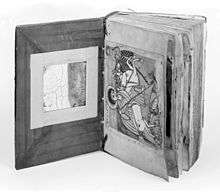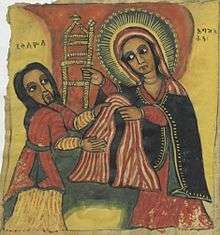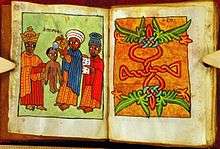Ethiopian manuscript collections

Ethiopian manuscripts are known to have reached Europe as early as the fifteenth century, perhaps even earlier, through Egypt, Ethiopian pilgrims to the Holy Land and through members of the Ethiopian monastery of St Stephen of the Abyssinians in Rome.[1] Subsequently, travellers, missionaries, military personnel and scholars contributed to the development of collections outside Ethiopia. In Europe, the three biggest collections of Ethiopian manuscripts are in Rome (Biblioteca Apostolica Vatican), in Paris (Bibliothèque nationale de France) and in London (British Library). These three organisations together hold about 2,700 manuscripts. Oriental collections of nearly all significant European libraries also have Ethiopian material, with some still pursuing a policy of acquisition.[2] In 1995, a key work for the disposition of Ethiopian MSS was prepared and published by Robert Beylot and Maxime Rodinson.[3]
Monasteries and modern institutions in Ethiopia have, meanwhile, maintained extensive collections and in some cases are still centres of manuscript production.
There are eighty eight languages in Ethiopia according to Ethnologue,[4] but not all support manuscript cultures. The majority of manuscripts are in Ge'ez, the ancient liturgical language of Ethiopia.
Accademia dei Lincei, Rome
The Accademia dei Lincei in Rome holds the collection of 138 manuscripts formed by Carlo Conti Rossini. The catalogue prepared by Stefan Strelcyn includes 30 further manuscripts in the Fonds Caetani.[5] The oldest manuscripts in the collections date to the fifteenth century with some having a provenance of Debre Damo.
Bibliothèque nationale de France, Paris

The collections in the Bibliothèque nationale (BnF), held primarily in the Département des Manuscrits, have been subject to several cataloguing campaigns. In 1877 a catalogue was published by Hermann Zotenberg and gave an account of the 170 manuscripts then in the collection.[6] The Ethiopic holdings were subsequently enlarged by the three collections, those of d'Abbadie, Casimir Mondon-Vidailhet,[7] and Marcel Griaule which increased the number at BnF to more than 970 manuscripts. Zotenberg's work was accordingly followed by a catalogue of the Mondon-Vidailhet collection prepared by M. Chaine.[8] The Griaule collection was published by Stefan Strelcyn.[9] The BnF has the largest single collection of magico-medical scrolls in France, with over 160 specimens in the Griaule collection.[10]
Bodleian Library, Oxford
The early collections at Oxford came from James Bruce, and consisted of 25 Ethiopic manuscripts purchased by the library in 1843. The collection soon grew to 33 manuscripts and these were catalogued and published in 1848 by August Dillmann.[11] Since the mid-nineteenth century the collection has expanded to 130 items. A notable addition in 2002 was an illustrated seventeenth-century manuscript of a Marian text, Arganona Weddase (‘Harp of Praise’) (MS. Aeth.e.28).[12] The uncatalogued manuscripts were revisited in 2007 by Steve Delamarter and Damaqa Berhāna Tafarā. [13]
British Library, London

The founding Ethiopic collections in the British Library -- 74 manuscripts -- came from the Church Mission Society and the materials that had been assembled by Karl Wilhelm Isenberg and Johann Ludwig Krapf, missionaries and linguists who travelled to the country between 1839 and 1842.[14] However, some of the collection has an earlier provenance, for example, Extracts from the Chronicle of Axum, written on paper in about 1810 with the book plate of George Annesley, 2nd Earl of Mountnorris.[15] In 1847 the Trustees of the British Museum published a catalogue of the Ethiopian manuscripts that were then under their care. This catalogue was prepared by August Dillmann and included 88 items.[16]
The British Library collections grew in 1868 when 349 manuscripts came after the British Expedition to Abyssinia against emperor Tewodros II.[17] A catalogue of the enlarged collection was prepared by William Wright (orientalist) and published in 1877.[18] Nine decades later, Stefan Strelcyn reviewed the manuscripts that had come to the British Library after 1877 and published a catalogue of them.[19] The catalogue lists 108 items (some with multiple parts) and covers the general range of Ethiopian literature from Biblical texts to magical and divinatory writings.
The transfer of the India Office collection to the British Library in 1982 brought 6 further manuscripts to the collection, first acquired in 1842 by the India Museum in East India House.
Cambridge University Library, Cambridge
The Ethiopic collections at Cambridge were catalogued by Edward Ullendorff.[20]The individual colleges at Cambridge also hold Ethiopic manuscripts and have given digital access to some of them.[21] The uncatalogued manuscripts were revisited in 2007 by Steve Delamarter and Damaqa Berhāna Tafarā.[13]
Chester Beatty Library, Dublin
The Chester Beatty collection of 58 Ethiopian manuscripts includes illustrated Gospel Books, psalters and devotional works. Chester Beatty purchased some of the collection at auction in London in the 1930s and bought the rest in the 1950s and later. [22] The manuscripts were studied and published by Cerulli in 1965.[23]
Edinburgh University Library, Edinburgh
Edinburgh University Library has a small collection of Ethiopic manuscripts acquired from a variety of sources. These are as follows: Or. MS 461-462 Acts of St. George according to Theodotus of Ancyra, with 20 illustrations, between boards; Or. MS 477, Or. MS 644, Or. MS 649, Or. MS 651, Or. MS 654, Or. MS 655 Psalms, Or. MS 656, Psalms, Or. MS 673 Gospels, portion (?), scroll format.[24]
Hill Museum & Manuscript Library, Collegeville
The Hill Museum & Manuscript Library is located at and sponsored by Saint John's Abbey and University in Collegeville, Minnesota, USA. The library holds a substantial number of photographs, images and digital copies of Ethiopian manuscripts and is host to the Ethiopian Study Center.[25] The library is also the home for the The Ethiopian Manuscript Microfilm Library (EMML).[26]
Institute of Ethiopian Studies, Addis Ababa
The Institute has a collection of approximately 1500 manuscripts, stll largely uncatalogued in 2012.[27] However a team led by Alessandro Gori undertook a listing exercise with regard to the Arabic materials and published the results in 2014.[28]
John Rylands Library, Manchester
The Rylands Library owns 45 items on parchment and paper, dating from the 1600s and later. The majority (31 items) came to the library from the Crawford collection, purchased in 1901.[29] In addition to a copy of the Fetha Nagast (Ge'ez: ፍትሐ ነገሥት) (Ethiopian MS 13) and a deed of Dawit III (Ethiopian MS 28), the collection includes a number of magic scrolls (Ethiopian MSS 29-34).
The first catalogue of the collection was prepared by Stefan Strelcyn and published in 1974.[30] The manuscripts were revisited and published in 2007 by Steve Delamarter and Damaqa Berhāna Tafarā.[13]
J. Paul Getty Museum, Los Angeles
.jpg)
The J. Paul Getty Museum acquired a single manuscript of the Gospels dating to the early sixteenth century in 2008.[31] A number of the folios are visible online through the museum's website as well as Wikicommons.
National Archives and Library of Ethiopia, Addis Ababa
National Archives and Library of Ethiopia has a collection of approximately 835 manuscripts, at present largely uncatalogued.[32]
Princeton University, Princeton, New Jersey
The core collection of Ethiopic manuscripts at Princeton was formed by Robert Garrett who collected 113 items in Ge’ez and Amharic and donated them to Princeton University Library in 1942. The collection is fully catalogued online.[33] Included in the collection are Psalters, Miracles of Mary, Prayer books, Homilies of Michael, Synaxaria, Anaphora of Addai and Mari, Missals and Gospels. Divination texts are also part of the collection. One of the Miracles of Mary is among the oldest and probably dates to the seventeenth century; the other materials mostly date to the eighteenth and nineteenth century. Garrett acquired most his Ethiopic manuscripts from Enno Littmann who led expeditions to Tigray Region and Axum in 1905 and 1906.[34] The Princeton collection has continued to grow through gift and purchase, and is especial strong in magico-medical srolls of which there are now more than 500 specimens.[35]
Of historiographical interest is the pseudepigraphical Book of Enoch (Ge'ez: መጽሐፈ ሄኖክ mätṣḥäfä henok).[36] The Princeton manuscript, according to a stamp on the old binding, belong to Rev. H. C. Reichardt who was in charge of the Damacus mission of the London Society for Promoting Christianity amongst the Jews from 1875 until his resignation in 1881.[37] The manuscript was one of several used by Robert Henry Charles (1855-1931) in his study of the Book of Enoch, and has since been commented on by Erho and Stuckenbruck.[38]
Schøyen Collection, Oslo
The Schøyen Collection of Ethiopian material was studied and published by David Appleyard.[39]
UCLA, Los Angeles
The Charles E. Young Research Library at UCLA had a core collection 64 Ethiopian manuscripts in Ge'ez, Agaw and Amharic.[40] Many were purchased by Wolf Leslau on the library's behalf during his research expeditions to Ethiopia in the 1960s. Subsequently, the library has acquired the extensive collection of Gerald and Barbara Weiner; this consists of 139 manuscripts and 110 scrolls.[41] The Library has made over 50 of their manuscripts visible online in digital format (see link below).

University of Oregon, Museum of Natural and Cultural History
The Museum of Natural and Cultural History (MNCH) has a small number of manuscripts in its collection pertaining to Ethiopian history and material culture. Most of the objects were gifted by Jayne Bowerman Hall as a tribute to her husband William O. Hall, U.S. Ambassador to Ethiopia from 1967 to 1971.[42] A catalogue of the collection was published in 2000.[43]

Vatican Library
In the 1990s, private collections of considerable size have been published and acquired by the Vatican.[44]
Walters Art Museum, Baltimore

The Walters Art Museum in Baltimore, Maryland, USA, has a small collection of manuscripts and Ethiopian art. Digital catalogues of some of this material is available, notably Walters Ms. W.768, Ethiopic Psalter with Canticles, Song of Songs, and two hymns in praise of Mary.[45] Ethiopian Gospels WDL13018 is available entire through Wikicommons.
Wellcome Collection, London

The Wellcome Collection was catalogued by Stefan Strelcyn and his Catalogue of Ethiopian manuscripts of the Wellcome Institute of the History of Medicine in London, published in 1972, is available online through the Wellcome Library.[46] The Wellcome originally had a collection of 34 manuscripts, acquired between 1913 and 1930. They retained 16 magico-medical scrolls and 1 divinatory manuscript; the remainder were transferred to the library of the British Museum in 1970 and 1971 and are now in the British Library.[47] According to Strelcyn, the Wellcome material "constitutes and good and very representative collection of this kind of Ethiopian literature."[48] The scrolls are dated to the eighteenth, nineteenth and early twentieth centuries based on Strelcyn's assessment of the palaeography.
References
- ↑ D. Nosnitsin, "Ethiopian Manuscripts and Ethiopian manuscript studies. A brief overview and evaluation," Gazette du livre médiéval, 58 (2012), 2–16.
- ↑ V. Six, “Neuzugang von äthiopischen Handschriften an die Staatsbibliothek zu Berlin, Preußischer Kulturbesitz,” Aethiopica 10 (2007), 177-83.
- ↑ Robert Beylot and Maxime Rodinson, Répertoire des Bibliothéques et des Catalogues de Manuscrits Éthiopiens (DNRS Editions; Paris: Centre National de la Recherche Scientifique, Éditions, 1995)
- ↑ Ethnologue page on Ethiopian languages
- ↑ Stefan Strelcyn, Catalogue des manuscrits éthiopiens de l'Accademia nazionale dei Lincei: fonds Conti Rossini et fonds Caetani 209, 375, 376, 377, 378 (Roma: Accademia nazionale dei Lincei, 1976).
- ↑ H. Zotenberg, Catalogue des manuscrits éthiopiens (gheez et amharique) de la Bibliothèque nationale (Paris, Imprimerie nationale, 1877). Available online at https://archive.org/details/manuscritsorient00bibl
- ↑ For him see: http://data.bnf.fr/15411049/casimir_mondon-vidailhet/ Accessed Sēptembre 2016
- ↑ M. Chaine, Catalogue des manuscrits éthiopiens de la collection Mondon-Vidailhet (Paris, Ernest Leroux, 1913). Available online at https://archive.org/stream/catalogueethiopia00bibluoft#page/n7/mode/2up
- ↑ Stefan Strelcyn, Catalogue des manuscrits éthiopiens (Collection Griaule). Ethiopien 301-304, 675-687 Tome IV (Paris: Impr. nationale, 1954).
- ↑ Sylvain Grébaut and S. Strelcyn, Catalogue des manuscrits éthiopiens de la Collection Griaule (Paris: Institut d'Ethnologie, 1938).
- ↑ August Dillmann, Catalogus codicum manuscriptorum Bibliothecae Bodleianae Oxoniensis. Pars 7 Pars 7 (Oxonii: E Typographeo Academico, 1848).
- ↑ Retrieved September 2016 https://www.bodleian.ox.ac.uk/weston/finding-resources/guides/hebrew
- 1 2 3 Steve Delamarter and Damaqa Berhāna Tafarā, A Catalogue of Previously Uncatalogued Ethiopic Manuscripts in England: Twenty-Three Manuscripts in the Bodleian, Cambridge University and John Rylands University Libraries and in a Private Collection, (Oxford: Oxford University Press on behalf of the University of Manchester, 2007).
- ↑ British Library, retrieved August, 2016: http://www.bl.uk/reshelp/findhelplang/ethiopic/ethiopiancoll/. See further: Isenberg and Krapf, Journals of Isenberg and Krapf (London, 1843), visible online at https://archive.org/stream/journalsofrevmes00isen/journalsofrevmes00isen_djvu.txt
- ↑ William Wright, Catalogue of the Ethiopic Manuscripts in the British Museum Acquired Since the Year 1847 (London: British Museum, 1877), 319. MS Add 19,341. The book was purchased at the Arley Castle sale of 1852.
- ↑ William Wright, Catalogue of the Ethiopic Manuscripts in the British Museum Acquired Since the Year 1847 (London: British Museum, 1877), iii. August Dillmann, Catalogus codicum manuscriptorum Orientalium qui in Museo Britannico asservantur. Pars tertia, Pars tetra (Londini: Impensis Curatorum Musei Britannici, 1847).
- ↑ Rita Pankhurst, "The library of Emperor Tewodros II at Mäqdäla (Magdala)," Bulletin of the School of Oriental and African Studies 36, no. 1 (1973): 15-42. http://dx.doi.org/10.1017/S0041977X00097974 Stéphane Ancel, Denis Nosnitsin, "On the History of the Library of Mäqdäla: New Findings," Aethiopica 17 (2014): 90-95, dec. 2014. ISSN 2194-4024. Available at: <http://journals.sub.uni-hamburg.de/aethiopica/article/view/859>. Date accessed: 30 Aug. 2016.
- ↑ William Wright, Catalogue of the Ethiopic Manuscripts in the British Museum Acquired Since the Year 1847 (London: British Museum, 1877), iii.
- ↑ Stefan Strelcyn, Catalogue of Ethiopian Manuscripts in the British Library Acquired Since the Year 1877 (London: British Museum Publications, 1978).
- ↑ E. Ullendorff, Catalogue of Ethiopian manuscripts in the Cambridge University Library (Cambridge, 1961).
- ↑ Retrieved August, 2016: http://trin-sites-pub.trin.cam.ac.uk/james/viewpage.php?index=152.
- ↑ Retrieved August, 2015 http://www.cbl.ie/Collections/The-Western-Collection/Manuscripts/Ethiopian.aspx
- ↑ Enrico Cerulli, I manoscritti etiopici della Chester Beatty Library in Dublino: memorial [Roma]: [Accademia nazionale dei Lincei], 1965.
- ↑ http://www.ed.ac.uk/files/atoms/files/h8_2_oriental_manuscripts_continued_from_hukk.pdf Retrieved August 2016
- ↑ Retrieved August, 2016, http://www.hmml.org/ethiopia-study-center.html
- ↑ Retrieved August, 2016: http://www.hmml.org/emml.html
- ↑ D. Nosnitsin, "Ethiopian Manuscripts and Ethiopian manuscript studies. A brief overview and evaluation," Gazette du livre médiéval, 58 (2012), 2–16.
- ↑ Alessandro Gori et al, Handlist of the Manuscripts in the Institute of Ethiopian Studies. The Arabic Materials for the Ethiopian Islamic Tradition, (Pickwick Publications: Eugene OR, 2014.
- ↑ Retrieved August, 2016: http://www.library.manchester.ac.uk/search-resources/guide-to-special-collections/atoz/ethiopian-manuscripts/. Also see Crawford Library.
- ↑ Stefan Strelcyn, Catalogue of Ethiopic Manuscripts in the John Rylands University Library of Manchester(Manchester, 1974).
- ↑ Retrieved August 2016 http://www.getty.edu/art/collection/objects/242418/unknown-maker-gospel-book-ethiopian-about-1504-1505/
- ↑ D. Nosnitsin, "Ethiopian Manuscripts and Ethiopian manuscript studies. A brief overview and evaluation," Gazette du livre médiéval, 58 (2012), 2–16.
- ↑ Retrieved August, 2016: http://findingaids.princeton.edu/collections/C0744.03/c0001
- ↑ Retrieved August, 2016: https://rbsc.princeton.edu/topics/316/divisions/15
- ↑ For a catalogue by David Appleyard: http://libweb5.princeton.edu/mssimages/ethiopic/index.html Retrieved August, 2016
- ↑ Retrieved August, 2016: http://pudl.princeton.edu/objects/zc77sr50z
- ↑ W. T. Gidney, The History of the London Society for Promoting Christianity Amongst the Jews From 1809 to 1908 (London: London Society for Promoting Christianity Amongst the Jews, 1908), 459.
- ↑ Ted M. Erho and Loren T. Stuckenbruck, "A Manuscript History of Ethiopic Enoch," Journal for the Study of Pseudoepigrapha, 23, no. 2 (2013), 87-131 (Garrett no. 42, see pp. 105-07).
- ↑ David L. Appleyard, Ethiopian Manuscripts (London: Jed Press, 1993).
- ↑ Retrieved, September 2016: http://www.oac.cdlib.org/findaid/ark:/13030/c8mc91d3/entire_text/
- ↑ Steve Delamarter, Marilyn Eiseman Heldman, Jeremy R. Brown, and Sara Vulgan, Ethiopian Scribal Practice 7: Plates for the Catalogue of the Ethiopic Manuscript Imaging Project : Companion to EMIP Catalogue 7 (Eugene, Oregon : Pickwick Publications, 2014), xxii.
- ↑ Retrieved September 2016: http://natural-history.uoregon.edu/collections/web-galleries/ethiopian-collection
- ↑ Norma Comrada, Thelma N. Greenfield, and Richard Pankhurst, William O. and Jayne Bowerman Hall Ethiopian Collection (Eugene, Or: University of Oregon Museum of Natural History, 2000).
- ↑ O. Raineri, Catalogo dei rotoli protettori della collezione Sandro Angelini, Roma 1990; O. Raineri, “Inventario dei manoscritti etiopici ‘Raineri’ della Biblioteca Vaticana”, in Collectanea in honorem Rev.mi Patris Leonardi E. Boyle, O.P..., (Città del Vaticano, 1998) (Studi e testi 385).
- ↑ Retrieved August, 2016 http://www.thedigitalwalters.org/Data/WaltersManuscripts/html/W768/description.html
- ↑ Retrieved August, 2016 http://wellcomelibrary.org/item/b20457303#?c=0&m=0&s=0&cv=0&z=-1.3295%2C-0.0926%2C3.6589%2C1.8513, also available through archive.org.
- ↑ Stefan Strelcyn, with his Catalogue of Ethiopian manuscripts of the Wellcome Institute of the History of Medicine in London, 27.
- ↑ Stefan Strelcyn, Catalogue of Ethiopian manuscripts of the Wellcome Institute of the History of Medicine in London, 28.
Complete manuscripts online
- British Library, Illustrated Gospels dating to the late 1600s (Or. MS 481). See: http://www.bl.uk/onlinegallery/sacredtexts/ethiopicgosp.html Note: To see the manuscript click through from this page at the bottom to Turning the PagesTM.
- Cambridge, Trinty College, Pslater (B.13.9). See http://trin-sites-pub.trin.cam.ac.uk/james/viewpage.php?index=152
- Princeton University Libirary, Book of Enoch, Mäṣḥafä Henok (C0744.03, Garrett Ethiopic Manuscripts, no. 42). See http://pudl.princeton.edu/objects/zc77sr50z
- UCLA Library, Digital Collections, a selection of 51 manuscripts visible online. See http://digital2.library.ucla.edu/viewItem.do?ark=21198/zz0009gx3x
- Walters Art Museum, Illustrated Gospels dating to the 1500s (Walters MS W850). See: https://commons.wikimedia.org/wiki/File:Ethiopian_Gospels_WDL13019.pdf
External links
- Universitätsbibliothek Johann Christian Senckenberg Frankfurt am Main https://www.ub.uni-frankfurt.de/hsn/ms_or.html
- The SGD Digital Collection: Previously Unknown and Uncatalogued Ethiopian Manuscripts in North America: https://www.sbl-site.org/publications/article.aspx?ArticleId=622#sthash.ZKvgqqQA.dpuf